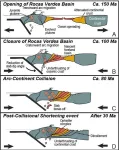(Press-News.org) Doctors are feeling unable to tackle growing problem of childhood obesity due to a lack of training and capacity according to new research.
In a paper published in the British Journal of General Practice, researchers from the University of Birmingham conducted in-depth interviews with healthcare professionals (HCPs) to understand their experiences of supporting families to tackle childhood obesity.
One participant in the study said:
“I had one mum and her child was overweight, but she was a young parent and she actually didn’t know how to cook the dinners and, yeah… we spent a lot of time with her giving her worksheets, how to cook, make potato and beans rather than going to the fish and chip shop.”
Among key themes that were discussed, professionals shared their frustrations with a lack of time and training to support families, including limited availability for specialist services and lack of access to routinely collected data on children’s weight. HCPs also shared their concerns about damaging trust by highlighting weight concerns about children, and many said that they were aware of cultural considerations when bringing up weight.
Miranda Pallan, Professor of Child and Adolescent Public Health in the Institute of Applied Health Research at the University of Birmingham and senior author of the paper said:
“This study brings a fresh awareness about the pressures that healthcare professionals face, including the limitations that they face in trying to provide preventative care for young people. Through the series of interviews with doctors, primary care nurses and school nurses, we have been able to see some clear barriers that prevent effective advice and support for families to tackle the growing epidemic of childhood obesity.
“While we should not expect doctors to be spending lots of time teaching families how to cook healthy, balanced meals, the study does highlight that healthcare professionals need more support and dedicated time to enable them to give practical advice and in some cases refer to more specialist services.”
Case study: “No-one is actually talking about the root causes with parents”
Dr Ellen Fallows is a sessional GP in North Oxfordshire and has a particular interest in supporting families to address childhood obesity. Also holding roles in teaching and as Vice-President of The British Society of Lifestyle Medicine, Dr Fallows regularly works with families who are struggling to understand where to go to get support, but with no specific paediatric weight management services locally often has to draw on her own expertise to provide advice.
Dr Fallows said: “Everyone thinks it is everyone else’s problem, no one is actually talking about the root causes with parents – which is predominantly food quality. This is due to lack of time, knowledge and incentives for healthcare professionals. There are good and free training resources out there that really should be routinely provided as a first port of call.
“Childhood obesity is a really serious problem that could have lifelong implications and GPs could be ideally placed to lead the work to address it. However, without the training and a mandate to support people with self-care to address root causes, it will continue to be a challenge to make a meaningful difference for the many families who are looking for help.”
Lack of trust in BMI
Healthcare professionals also raised the issue of the use of BMI centiles for assessing weight problems in children.
Different healthcare professionals raised different concerns, with doctors and primary care nurses noting that they are less familiar with BMI centiles, and that BMI is not a good measure for younger children.
Another participant said:
“We used to use the [height and weight] centile charts and actually the BMI will put a lot more children in an overweight category than the centile charts will.”
ENDS
For media enquiries please contact Tim Mayo, Press Office, University of Birmingham, tel: +44 (0)7815 607 157 or contact pressoffice@contacts.bham.ac.uk
Notes to editor:
The University of Birmingham is ranked amongst the world’s top 100 institutions. Its work brings people from across the world to Birmingham, including researchers, teachers and more than 8,000 international students from over 150 countries.
The University of Birmingham is a founding member of Birmingham Health Partners (BHP), a strategic alliance which transcends organisational boundaries to rapidly translate healthcare research findings into new diagnostics, drugs and devices for patients. Birmingham Health Partners is a strategic alliance between seven organisations who collaborate to bring healthcare innovations through to clinical application:
University of Birmingham
University Hospitals Birmingham NHS Foundation Trust
Birmingham Women's and Children's Hospitals NHS Foundation Trust
Aston University
The Royal Orthopaedic Hospital NHS Foundation Trust
Sandwell and West Birmingham Hospitals NHS Trust
West Midlands Academic Health Science Network
Birmingham and Solihull Mental Health NHS Foundation Trust END
Doctors on front line of tackling childhood obesity but more training and resources needed
2024-04-03
ELSE PRESS RELEASES FROM THIS DATE:
Galaxies get more chaotic as they age
2024-04-03
Galaxies start life with their stars rotating in an orderly pattern but in some the motion of stars in more random. Until now, scientists have been uncertain about what causes this – possibly the surrounding environment or the mass of the galaxy itself.
A new study, published in a paper today in MNRAS (Monthly Notices of the Royal Astronomical Society), has found that the most important factor is neither of these things. It shows the tendency of the stars to have random motion is driven mostly by the age of the galaxy – things just get messy over time.
“When we did the analysis, we found that age, consistently, whichever way we slice or dice it, is always the most ...
Sandia pumps $140B into the economy through technology development
2024-04-03
ALBUQUERQUE, N.M. — To say that the technology and products Sandia National Laboratories researchers have helped imagine, innovate and industrialize have had a massive impact on the country would be an understatement.
Two studies commissioned by Sandia and the National Nuclear Security Administration show Sandia’s work has had an overall economic impact of $140 billion since the year 2000. That’s a significant figure, especially considering it spans just 20 years, less than a third of Sandia’s 75-year existence.
“I am very proud of how Sandia excels in fulfilling its technology transfer mission to deliver economic impact to the U.S.,” ...
Even moderate alcohol usage during pregnancy linked to birth abnormalities, UNM researchers find
2024-04-03
University of New Mexico researchers have found that even low to moderate alcohol use by pregnant patients may contribute to subtle changes in their babies’ prenatal development, including lower birth length and a shorter duration of gestation.
In a new paper published in the journal Alcohol Clinical & Experimental Research, a team led by Ludmila Bakhireva, MD, PhD, MPH, professor and assistant dean for Clinical and Translational Research in the UNM College of Pharmacy, also reported some sex-related differences in the effects of drinking during pregnancy on the developing ...
Sylvester physician co-authors global plan to combat prostate cancer
2024-04-03
MIAMI, FLORIDA (EMBARGOED UNTIL APRIL 4, 2024, at 6:30 pm EDT) – Annual prostate cancer cases worldwide are projected to double by the year 2040, and annual deaths are projected to increase by 85% to almost 700,000 over the same timeframe – mainly among men in low- and middle-income countries. A commissioned report published online in The Lancet on April 4 highlights the future landscape of prostate cancer and seeks to guide cancer experts worldwide on how to manage the massive influx of prostate cancer patients projected over the next two decades.
Brandon Mahal, M.D., radiation oncologist and ...
Last chance to record archaic Greek language ‘heading for extinction’
2024-04-03
A new data crowdsourcing platform aims to preserve the sound of Romeyka, an endangered millennia-old variety of Greek. Experts consider the language to be a linguistic goldmine and a living bridge to the ancient world.
The initiative, led by Professor Ioanna Sitaridou from the University of Cambridge, contributes to the UN’s International Decade of Indigenous Languages (2022-32), which aims ‘to draw global attention on the critical situation of many indigenous languages and to mobilise stakeholders and resources for their preservation, revitalization and promotion.’
Romeyka is thought to have only a couple of thousand ...
Chicks prove vision and touch linked at birth
2024-04-03
Newly hatched chicks raised in darkness and allowed to touch either a smooth or bumpy cube for 24 hours instantly recognised the object with their vision upon first exposure to light.
This suggests chicks can link touch and vision without any prior experience combining these senses, challenging the long-held belief that such integration requires learning.
The discovery implies a pre-wired ability in the brain for cross-modal perception, potentially redefining our understanding of animal cognition and sensory processing.
In a study published in Biology Letters, researchers at Queen Mary University of London have cracked ...
Researchers propose new step in tectonic squeeze that turns seafloor into mountains
2024-04-03
Scientists use tiny minerals called zircons as geologic timekeepers. Often no bigger than a grain of sand, these crystals record chemical signatures of the geological environment where they formed. In a new study led by scientists at The University of Texas at Austin, researchers used them to describe what could be an overlooked step in a fundamental tectonic process that raises seafloors into mountains.
In a study published in the journal Geology, the researchers describe zircons from the Andes mountains of Patagonia. Although the zircons formed when tectonic plates were colliding, they have a chemical signature associated ...
Gut bacteria that strongly influence obesity are different in men and women, study finds
2024-04-03
Novel approach finds gut microbiota that are highly predictive of BMI, waist circumference, and fat mass are different in men and women
And might change the chemical makeup (metabolome) of the gut in ways that affect the metabolism of different bioactive molecules that influence metabolic disease development
Interventions to help prevent obesity-favourable microbiome may need to be different in men and women
*This is an early press release from the European Congress on Obesity (ECO 2024) Venice 12-15 May. Please credit the Congress if using this material*
New research being presented at this year’s European ...
Double trouble: the risks of mixing alcohol and sports wagering
2024-04-02
It turns out that money isn’t the only thing sports gamblers are risking. According to a new study, bettors who wager on sporting events, esports, and daily fantasy sports are much more likely than other individuals to binge drink.
The findings, compiled by a research team from UNLV and the University of New Mexico, were published this week in the journal JAMA Network Open.
Over the course of three weeks in spring 2022, researchers surveyed more than 4,300 adults across the U.S. Nearly 3,300 self-reported past year alcohol use, while about 1,800 identified themselves as gamblers who had bet on sports in the past year.
Researchers ...
Far-UVC light can virtually eliminate airborne virus in an occupied room
2024-04-02
NEW YORK, NY--Far-UVC light is a promising new technology for reducing airborne virus levels in occupied indoor spaces, but its effectiveness has not been evaluated in real-life scenarios.
A new study by Columbia researchers now shows that far-UVC light inactivated nearly all (>99%) of an airborne virus in an occupied work environment, showing that the technology can work as well in a real-life scenario as in the laboratory.
“The results show that far-UVC is highly effective at reducing airborne pathogens in an ordinary occupied room, and so it’s practical to use far-UVC light in indoor areas where people are going about their business,” says David ...





